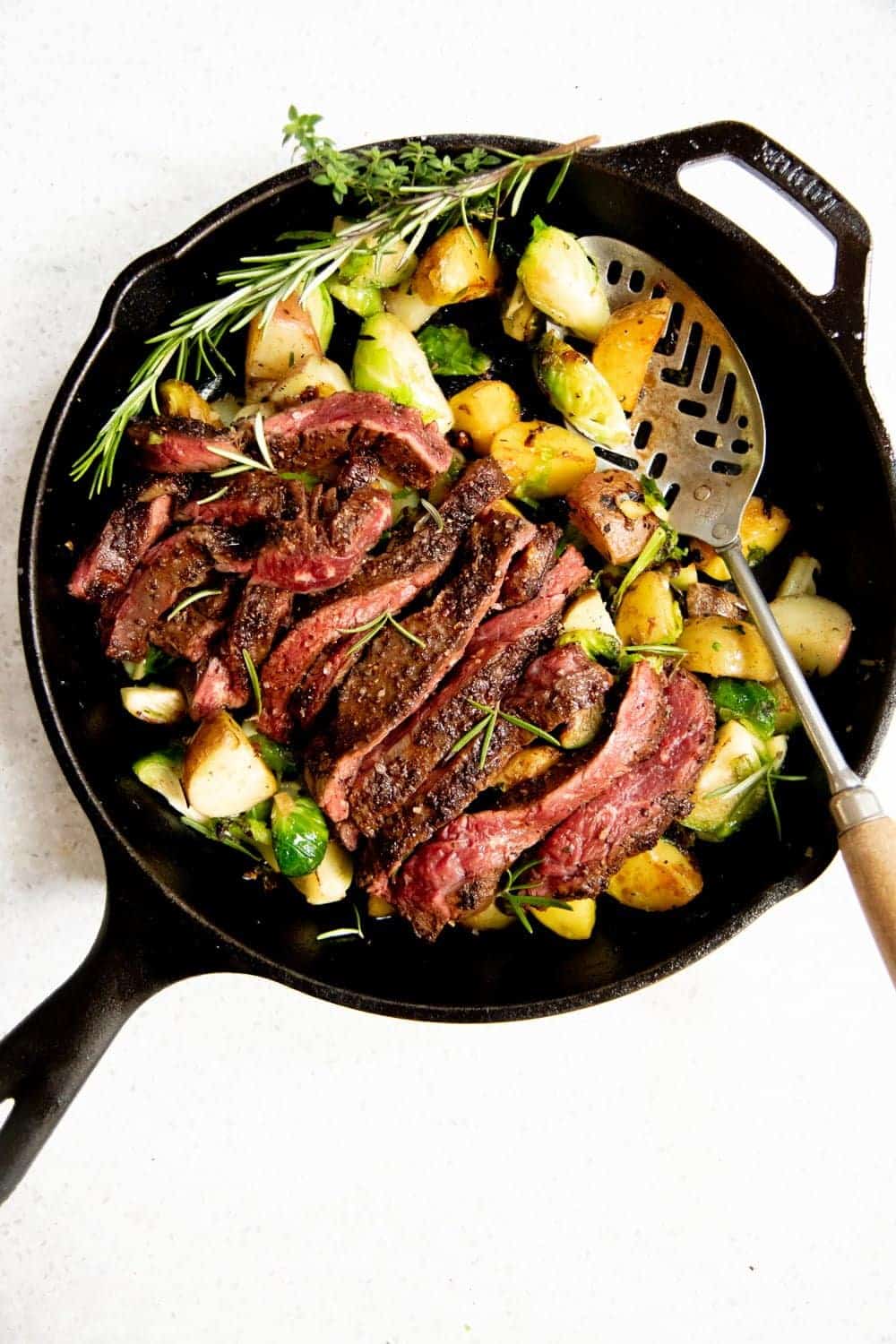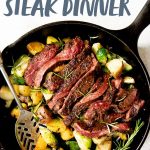This one-skillet steak and vegetables dinner is not only a feast for the senses but also a testament to the magic of simple, quality ingredients coming together to create a memorable meal. If a coffee-rubbed steak sounds like a strange combo to you, let me tell you, it’s a delicious marriage of flavors. When I seared the steak with the coffee rub, it got a beautiful smoky-sweet crust that really complemented the flavor of the steak.
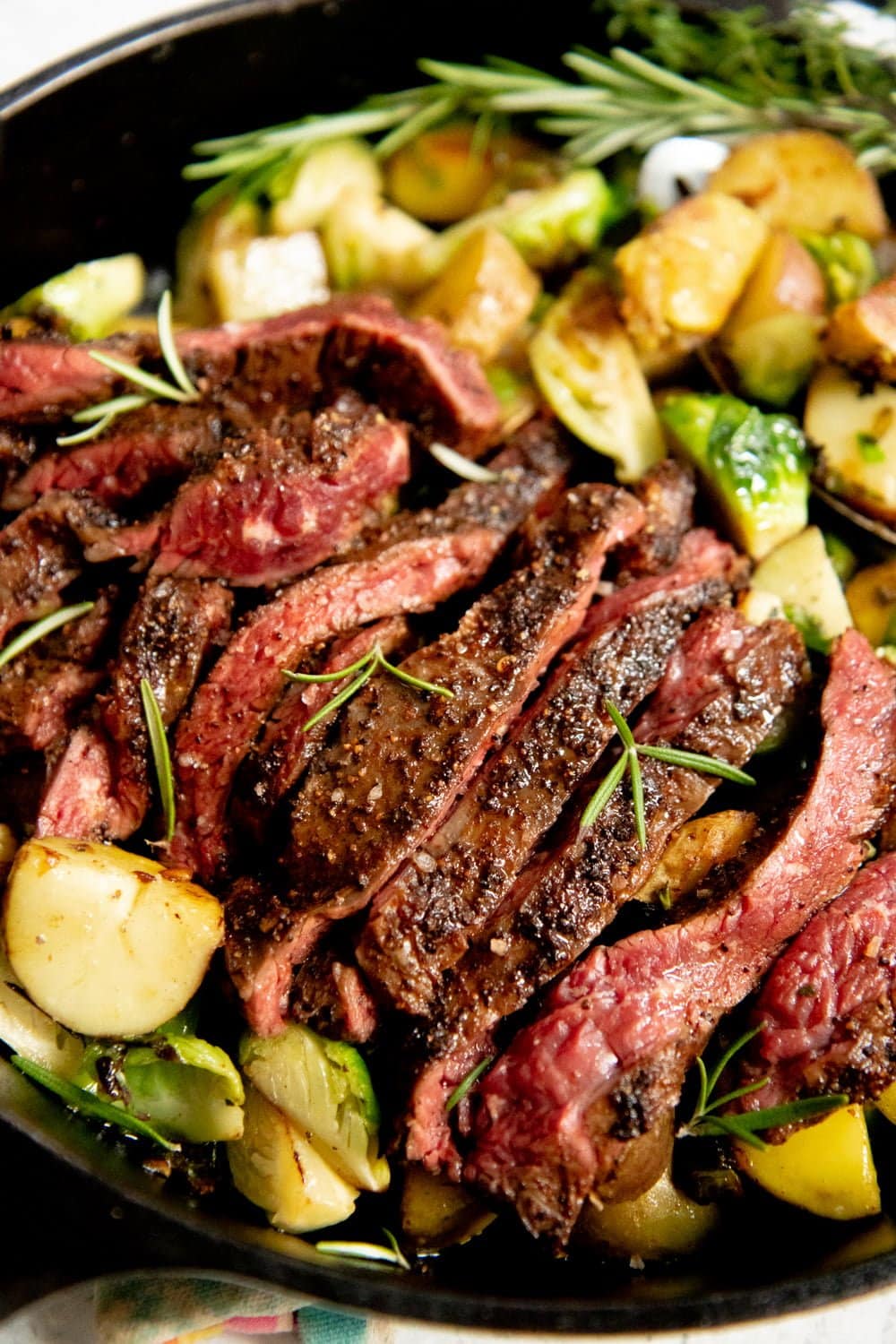
What’s a skirt steak?
If you’ve never worked with skirt steak before, it’s a bit of an odd-looking cut of meat—it’s long and thin and doesn’t look at all like a typical “steak” shape (think: not the steak emoji shape). Since skirt steak is so thin, it absorbs dry rubs and marinades quickly and cooks in a jiffy (meaning this whole meal is done in right around a half hour). And when you cut across the grain, the bites are tender and rich. Because of how long and skinny the cut of meat is, you’ll probably want to cut it into equal-size sections to be able to fit into your skillet and get a good sear.
Protip: Steak substitutions
If you can’t find skirt steak, you can substitute in flank steak. You may need to add an extra 1-2 minutes of cook time on each side of the steak—use the internal temperature or the hand test (more on both in a second) to determine when the steak is done.
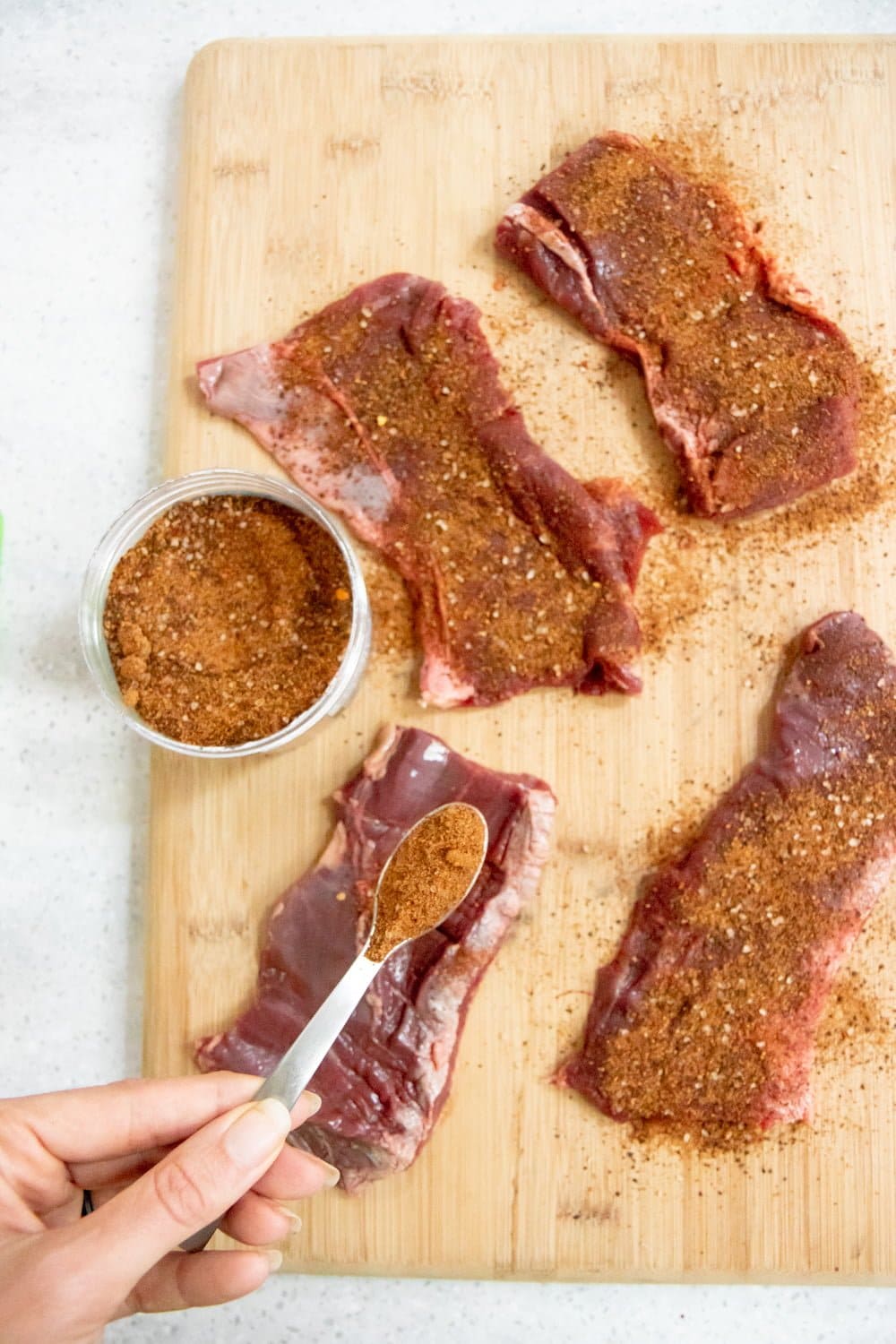
How do I know the steak is done cooking?
There are two ways to determine when your steak is done:
- The internal temperature. When a meat thermometer is inserted into the thickest part of the steak (and not touching bone), the temperature should be 125°F for a rare steak, 135°F for medium rare, or 145°F for medium doneness.
- The hand test. Press on the steak with one finger, and see how it feels compared to different parts of your hand. First, find the fleshy area between the bottom of your thumb and your palm. When the beef feels like that area below your thumb when your hand is relaxed, it is still raw. Touch the tip of your thumb to the tip of your pointer finger—now that fleshy area is what a rare steak should feel like. Touching the tip of your middle finger to your thumb will show you what medium-rare feels like. You can see photos of this test and how to use it at Simply Recipes.
Do I have to use a cast iron skillet for these steak and vegetables?
You can technically use any skillet you want, but this meal is just begging to be made in cast iron. We really recommend going with your beloved cast iron skillet here. Why?
It’s going to give you the most even heat, the best sear on the steak, and my gosh, doesn’t this meal just look all kinds of cozy when it’s packed into a heavy cast iron skillet? This is how you do cooler weather food. Bonus that my doctor is a fan of: cooking in cast iron has been shown to raise the iron levels of your food.
Protip: Sheet pan dinners
No cast iron skillet? Try our sheet pan steak and potatoes dinner instead!
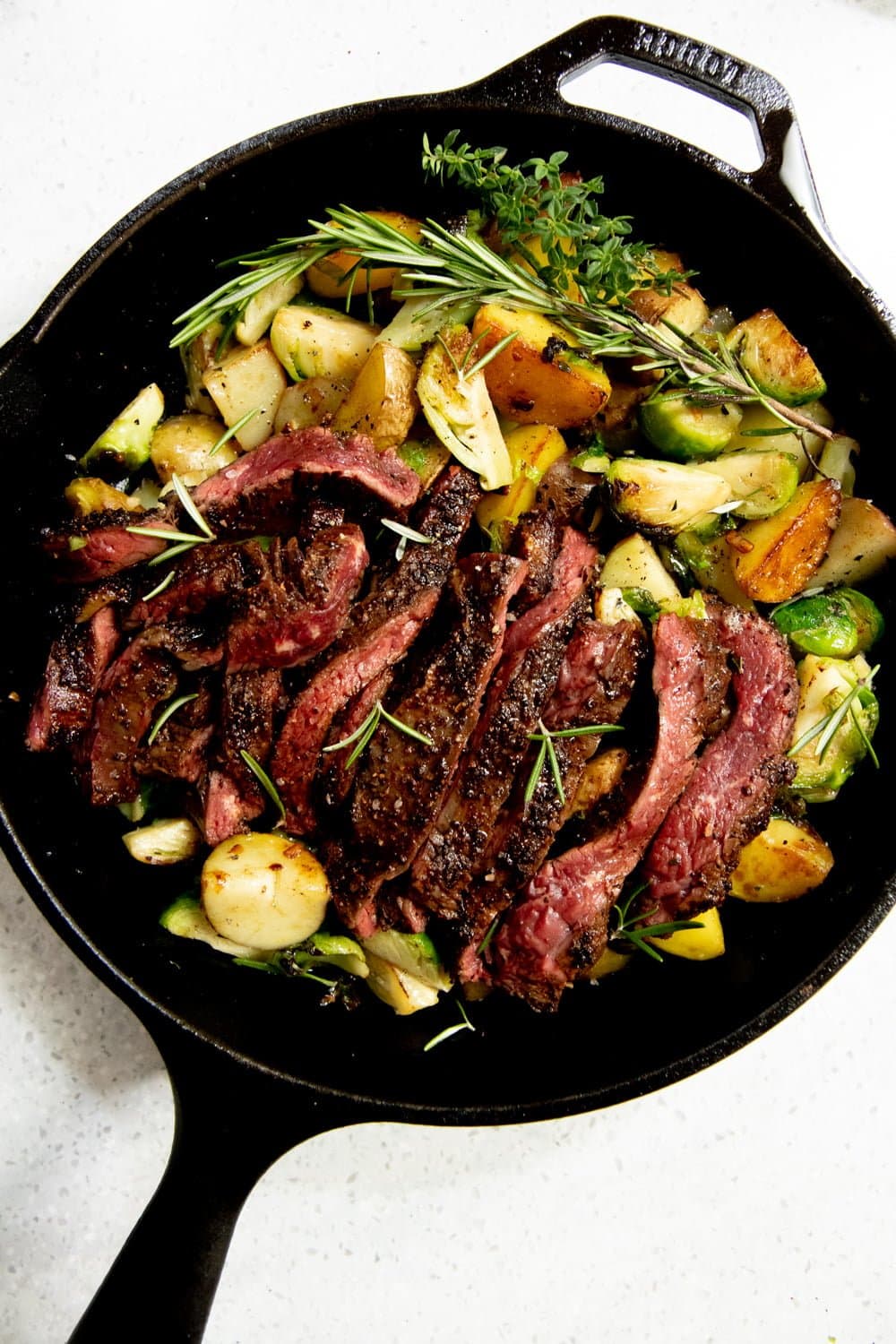
What size skillet do I need?
The most common cast iron skillet size in the home is a 10″, and that’ll totally work for this recipe—but you will have to do some batch-cooking. A better bet would be to invest in a 12″ or even larger skillet for one-pot meals like these. The extra two inches might not seem like it’ll make a big difference, but giving your steak and vegetables a little bit of breathing room really helps to get good caramelization on the potatoes and Brussels sprouts, and a good, crusty sear on the coffee-rubbed steak.
I know cast iron skillets aren’t cheap, but as we explored in my Cast Iron 101 post, investing in a good piece of cast iron cookware is a lifetime (and more!) investment. We frequently use cast iron skillets in my family that are from three generations before me. And a larger cast iron skillet is perfect for cooking over the campfire or cooking big batches of food for guests.
That being said, the pictures you see here are the standard 10″ cast iron skillet—because I know that’s what most of you folks have in your home kitchen, and I wanted to make sure to test this recipe using what you already have. Trust me, it works just fine (and shoo-wee, is it delicious).
Can I use different vegetables?
We haven’t tried this particular recipe with other vegetables, but we don’t see why not! Try subbing in chopped carrots, broccoli florets, or chopped onion for some or all of the Brussels sprouts. You can also try more tender veggies like mushrooms, green beans, or asparagus, but they will need less time in the skillet—you’ll want to add them later in the cooking process.
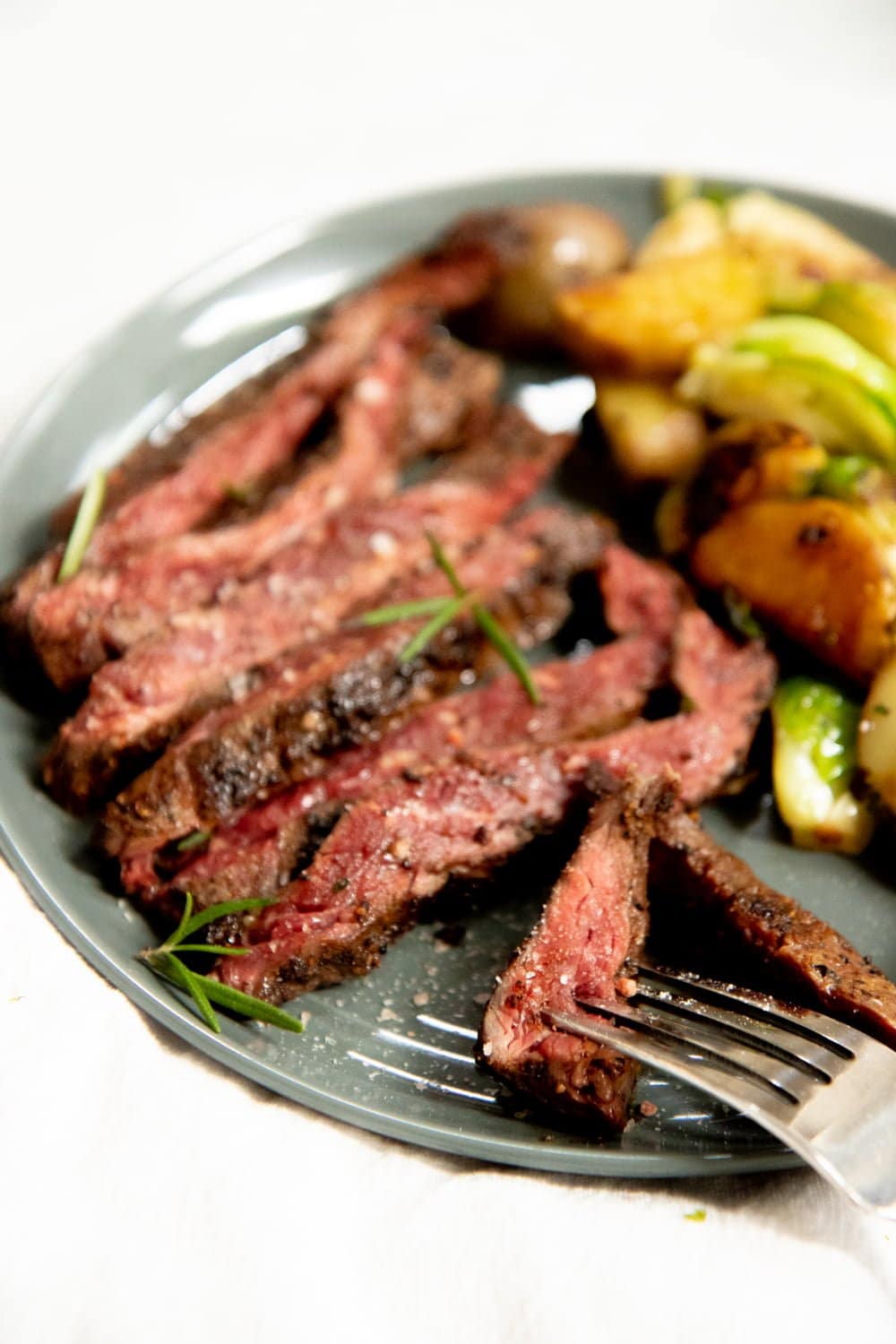
What is steak most commonly served with?
At steakhouses, steak is usually served with some form of potato and a veggie side or two. For this dish, we cook the whole meal in one skillet—coffee-rubbed steak, roasted potatoes, and caramelized Brussels sprouts.
How do I store the leftovers?
You can refrigerate any leftover steak and vegetables in an airtight container in the fridge for up to three days.
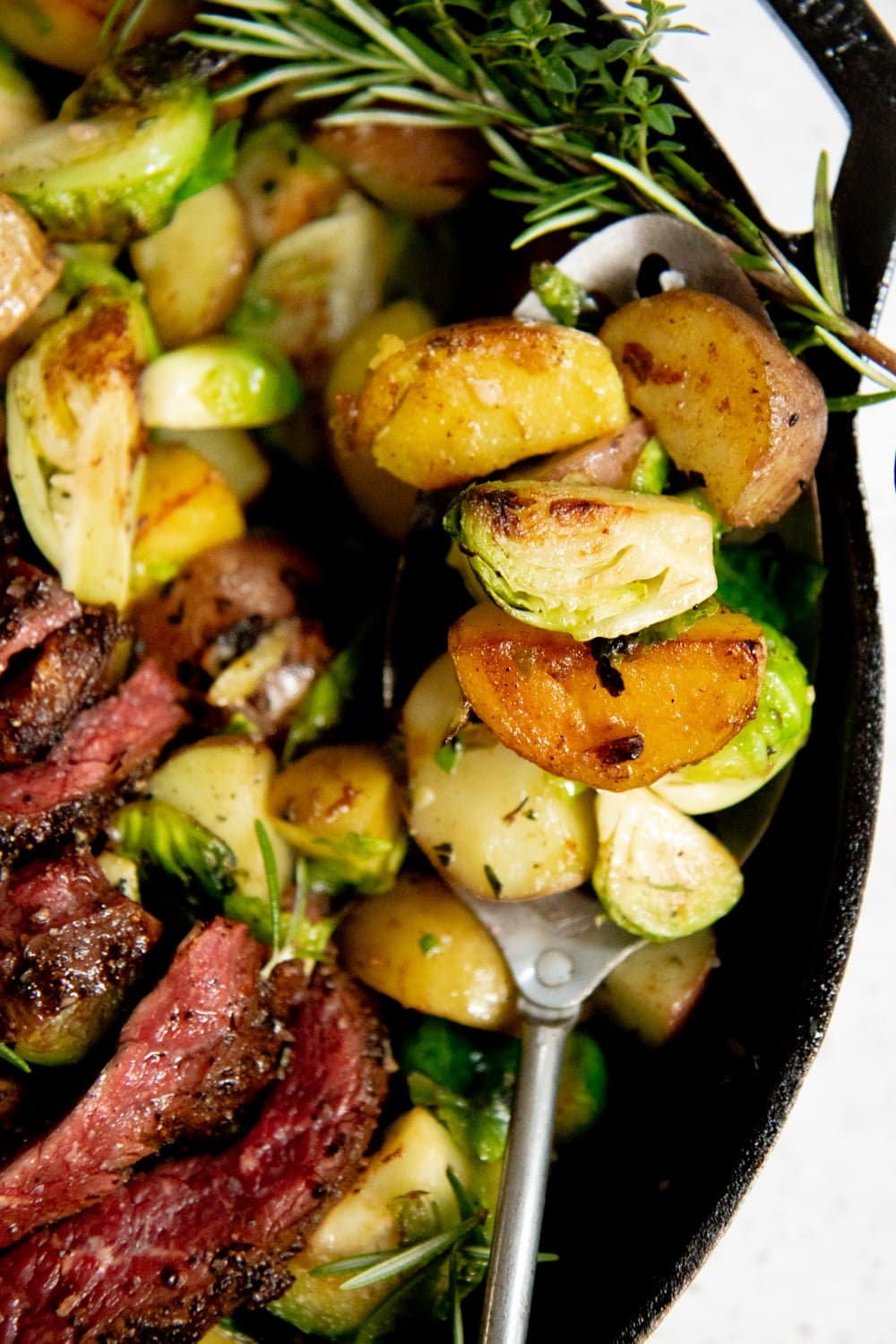
Want more easy dinners like this one?
- Sheet pan chicken and veggies
- Sheet pan sausage and veggies
- Instant Pot white chicken chili
- Beef-stuffed zucchini boats
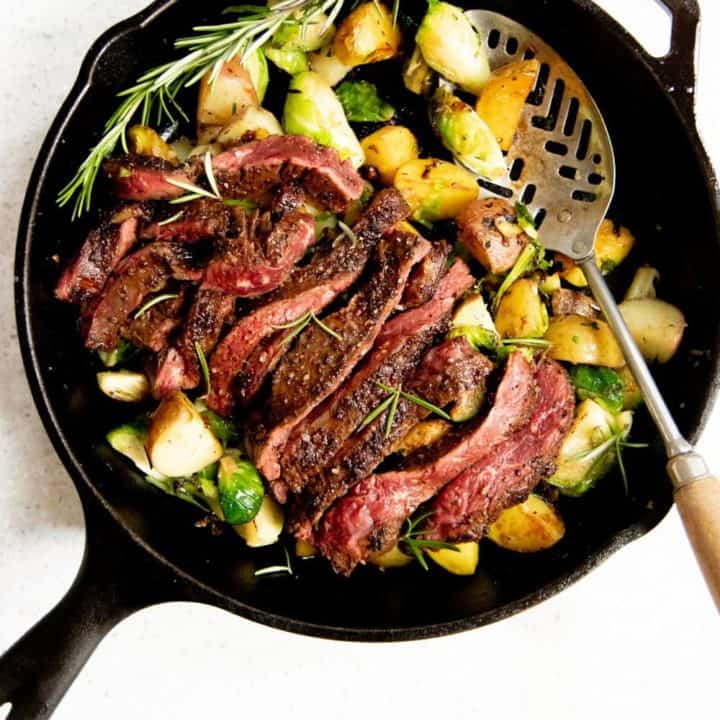
One Skillet Steak and Vegetables Dinner
Enjoy this bold one-skillet steak and vegetable dinner. The smoky seasoning on the steak and the caramelized edges on the veggies add so much flavor!
Ingredients
- 1 pound skirt steak, cut into four equal pieces
- 1/4 cup Coffee Steak Rub(see notes for substitutions)
- 5 tablespoons avocado oil, divided
- 4 tablespoons butter or ghee, divided
- 1 pound Yukon gold potatoes, cut into 1/2” pieces
- 4 cloves garlic, finely minced
- 1 pound Brussels sprouts, trimmed and quartered
- 1 tablespoon fresh thyme, chopped
- 1 tablespoon rosemary, chopped
- Salt and pepper, to taste
Instructions
- Place the skirt steak sections onto a large cutting board. Cover both sides of the steak liberally with the Coffee Steak Rub. Cover loosely, and set aside on the counter to come up to room temperature.
- In a 10” or larger cast iron skillet, heat 2 tablespoons of avocado oil and 2 tablespoons butter or ghee over high heat.
- Add in the potatoes, stir to coat with the fats, and then cook until the undersides have a nice, crispy sear on them—about 3 minutes. Stir and reduce heat to medium. Cook, stirring occasionally, until most of the potatoes are golden brown, and the texture is just before fork-tender (you want a little resistance when you push the fork in), about 10 minutes.
- Push the potatoes to one side of the skillet, then add one tablespoon of avocado oil to the empty side of the skillet. Add in the garlic in the empty space, and sauté until just softened and fragrant, about a minute.
- Add the Brussels sprouts and spread to fill the space, and cook until the bottom side of the sprouts begin to caramelize and turn brown—about 5 minutes.
- Mix up the potatoes and Brussels sprouts in the skillet and continue to cook, stirring occasionally, until both the potatoes and Brussels sprouts are fork tender—about 5 more minutes.
- Add in the thyme and rosemary, season with salt and pepper, then transfer to a plate and keep warm.
- Return the skillet to high heat, and then add in the remaining avocado oil and butter or ghee. If using a 10” skillet, add two pieces of the skirt steak at a time. Cook until the underside has a nice sear, about 2 minutes. Flip the meat and cook an additional minute for rare steak, or an additional 2-3 minutes for a well-done steak. Remove steak and let rest on a cutting board, and then repeat with remaining steak pieces. If using a 12” or larger skillet, you should be able to fit all four pieces in the skillet at once.
- Allow the steak to rest for 10 minutes, then slice across the grain into long, thin strips. Serve immediately with the Brussels sprouts and potatoes.
Notes
- If you don't have a Coffee Steak Rub, you can make it at home by combining 2 tablespoons finely ground espresso-roast coffee, 2 tablespoons chili powder, 2 tablespoons coconut sugar or brown sugar, 1 teaspoon oregano, 1 teaspoon dry mustard, 1 teaspoon fresh cracked black pepper, and 1 teaspoon sea salt. Whisk the ingredients together in a small bowl, and store any leftovers in an airtight container until next time.
Nutrition Information:
Yield: 4 Serving Size: 1 servingAmount Per Serving: Calories: 872Total Fat: 59gSaturated Fat: 22gTrans Fat: 0gUnsaturated Fat: 33gCholesterol: 160mgSodium: 325mgCarbohydrates: 37gFiber: 6gSugar: 6gProtein: 49g
At Wholefully, we believe that good nutrition is about much more than just the numbers on the nutrition facts panel. Please use the above information as only a small part of what helps you decide what foods are nourishing for you.

